Are you wondering if your 1987 Lincoln penny holds any real value?
While it may seem old, the 1987 cent is still considered a modern coin in the world of numismatics. As such, most examples you’ll come across today are quite common and not especially valuable.
Still, if you’re just getting started with coin collecting, this is a great coin to include in your set. It’s affordable, easy to find, and offers some interesting variations that might surprise you.
For those looking to sell, most 1987 pennies will only bring in a few cents—unless you happen to have one in exceptional condition or with a notable mint error.
In this guide, we’ll walk you through everything you need to know about this coin, from its historical background to the market value of circulated, uncirculated, and error varieties.
So, let’s get into it and answer the big question: Can a 1987 penny be worth real money?
1987 Lincoln Penny Value Table
| Mint | MS60 | MS63 | MS65 | MS67 / PR69 DCAM |
|---|---|---|---|---|
| 1987 (No Mint Mark) | – | $6 | $10 | $26 |
| 1987-D | – | $5 | $10 | $28 |
| 1987-S (Proof) | $1 | $2 | $4 | $14 |
Note: The listed values apply to coins with a “red” color designation, meaning they retain their original luster and have not darkened over time.
History of the 1987 Penny

The Lincoln penny, officially known as the Lincoln cent, has been a cornerstone of U.S. coinage since it was first issued in 1909. Initially, these coins were dubbed “Wheat Pennies” because of the two stylized wheat stalks on the reverse side, a design that remained in use until 1958.
In 1959, to commemorate the 150th anniversary of Abraham Lincoln’s birth, the Lincoln Memorial was introduced as the new reverse design, replacing the wheat ears. Although the obverse still features Lincoln’s portrait, the reverse has evolved over time, reflecting different artistic and historical milestones.
The idea of revamping American coinage can be traced back to President Theodore Roosevelt, who in 1904 urged the U.S. Mint to improve the aesthetic appeal of the nation’s coins. In response, the Mint commissioned Augustus Saint-Gaudens in 1905 to redesign several denominations, including the cent.
Saint-Gaudens managed to submit new designs for the gold coinage, two of which were later adopted. Unfortunately, he passed away in 1907 before completing his work on the penny. This led to the hiring of another talented artist, Victor David Brenner, in 1909.
That same year marked Lincoln’s 100th birthday, and the Mint requested that Brenner incorporate Lincoln’s likeness into the new cent—making it the first regular-issue U.S. coin to feature a president’s portrait.
After some refinements, Brenner’s design was officially approved, and the new penny was released to the public in August 1909. However, controversy quickly followed. The coin featured Brenner’s initials, “V.D.B.”, prominently on the reverse. Critics saw this as a form of self-promotion, and the Mint responded by removing the initials shortly after the coin’s release.
Still, a number of these 1909 VDB pennies had already entered circulation, and today they are among the most collectible and valuable Lincoln cents available.
Later, in 1959, artist Frank Gasparro was tasked with creating a new reverse design featuring the Lincoln Memorial, further honoring the president’s legacy.
Originally, Lincoln pennies were struck using a 95% copper alloy. But due to rising copper prices in the early 1980s, the Mint made a significant change. Starting in 1982, the coins began to be produced with a zinc core coated in copper, a composition that remains standard to this day.
Features of the 1987 Penny
The Obverse of the 1987 Penny
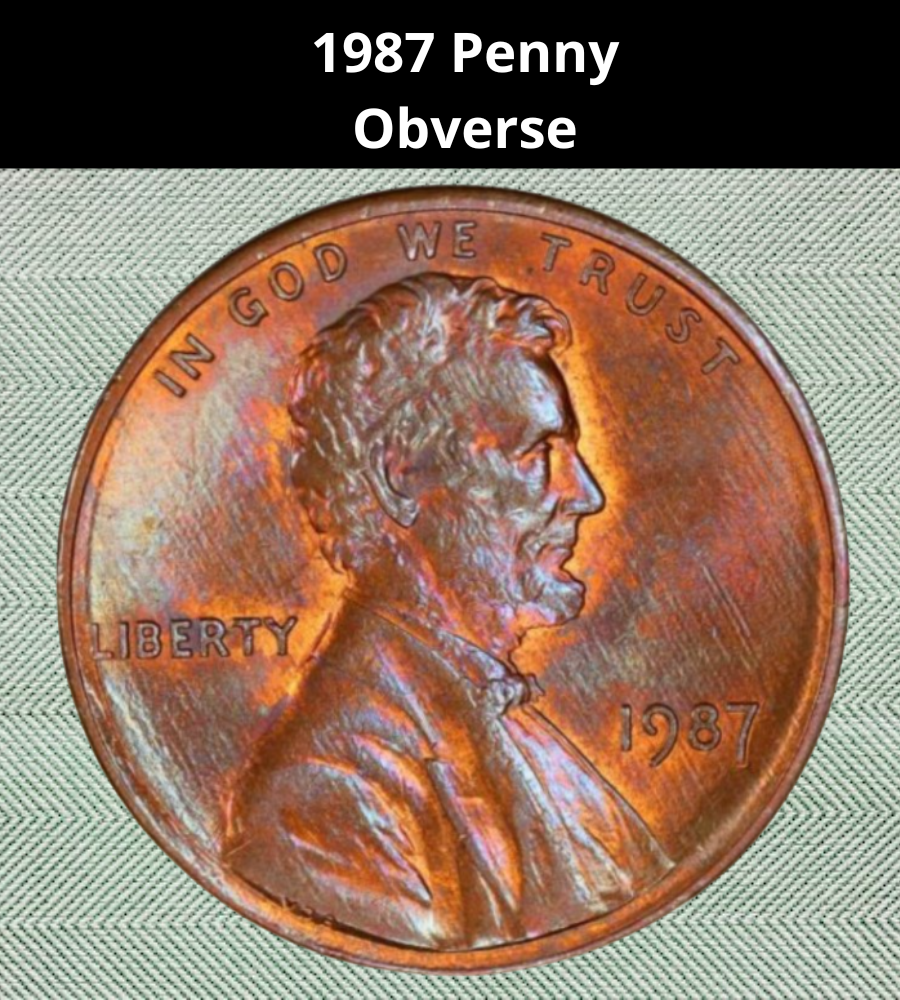
The front (obverse) of the 1987 Lincoln penny features a right-facing portrait of President Abraham Lincoln, a design inspired by artist Victor David Brenner’s earlier works, including a commemorative plaque and reference photographs of Lincoln.
At the top of the coin, along the inner edge, you’ll find the national motto: “IN GOD WE TRUST”.
On the left-hand side, the word “LIBERTY” is inscribed, while the year of issue, 1987, appears just to the right of Lincoln’s neck, completing the classic and enduring layout of the Lincoln cent’s obverse.
The Reverse of the 1987 Penny
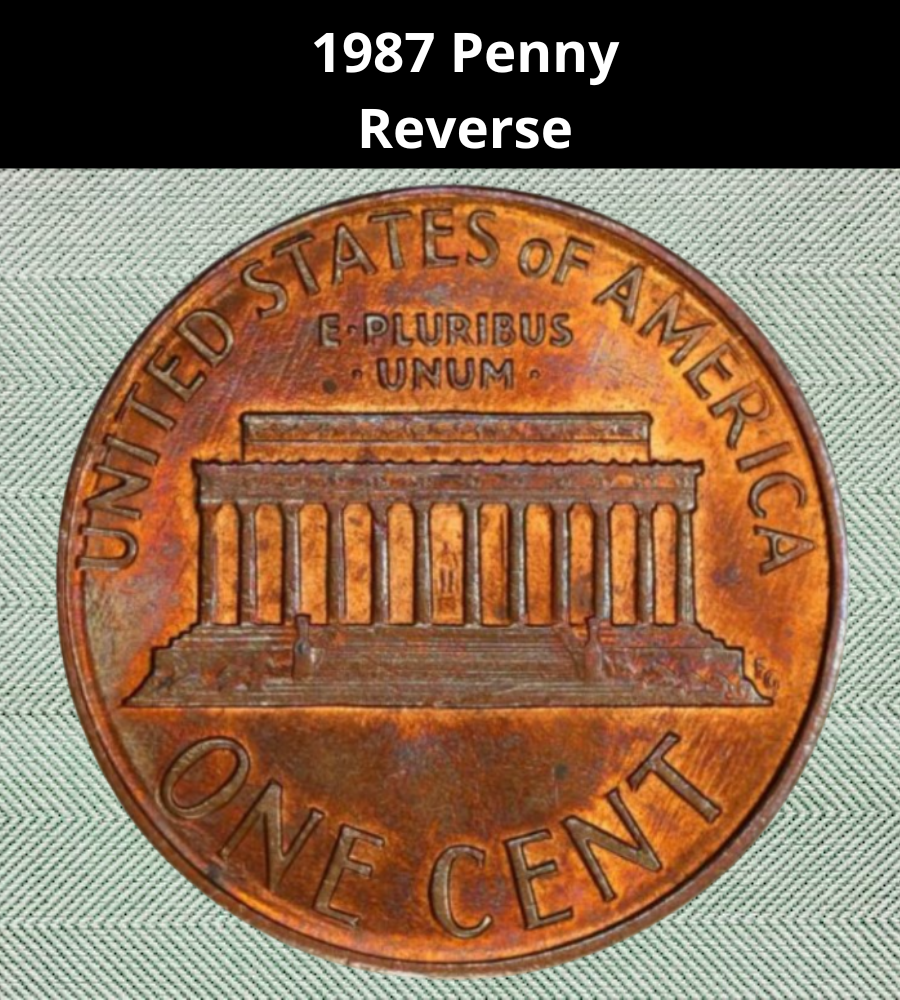
Reverse Design and Specs of the 1987 Penny
The back side of the 1987 Lincoln penny features the Lincoln Memorial, which dominates the reverse design.
If you look closely, you can actually make out the tiny seated statue of Abraham Lincoln inside the memorial—an impressive touch, especially considering that Frank Gasparro, the coin’s designer, had never seen the monument in person.
To the far right, near the steps of the Memorial, you’ll spot the initials “FG”, standing for Frank Gasparro.
At the top edge of the coin, you’ll see the words “UNITED STATES OF AMERICA”, and just below that, the Latin motto “E PLURIBUS UNUM”, meaning “Out of many, one.”
The denomination “ONE CENT” appears in bold letters along the lower rim of the coin.
Other Details About the 1987 Penny
Despite its small size—just 19.00 millimeters in diameter and weighing 2.5 grams—the 1987 penny carries a lot of historical significance. It’s made from zinc with a thin copper coating and has a plain (smooth) edge.
This year’s Lincoln cents were minted in three U.S. facilities:
- Philadelphia (no mint mark)
- Denver, which is marked with a “D” below the year on the obverse
- San Francisco, which struck high-quality proof coins
As usual, coins from Philadelphia don’t carry any mint mark. The Denver coins have a clear “D”, while proofs from San Francisco come with sharp, polished finishes but no visible mint mark either.
How to Grade a 1987 Lincoln Penny
If you’re looking to collect 1987 pennies, your best bet is to go after uncirculated examples. Coins that have been in circulation are extremely common and usually show enough wear that their value doesn’t exceed one cent.
To qualify as mint state, a 1987 Lincoln penny should show a strong, uninterrupted shine (luster) across both the front and back. Look carefully at high areas of the obverse such as:
- Lincoln’s hairline, cheek, jawline, beard, and shoulder
These spots should have no signs of flattening, fading, or smooth texture.
On the reverse, inspect the Lincoln Memorial steps. A high-grade coin will have clear, well-defined steps with no worn areas. Also check the “ONE CENT” inscription—this area wears down easily and should remain sharp and bright in uncirculated coins.
Penny Grading Scale
| Grade # | Description |
|---|---|
| 1 | Basal State |
| 2 | Fair |
| 3 | Very Fair |
| 4–6 | Good |
| 7–10 | Very Good |
| 12–15 | Fine |
| 20–30 | Very Fine |
| 40 | Extremely Fine |
| 50 | About Uncirculated |
| 60 | Mint State (Entry Level) |
| 65 | Mint State (Gem) |
| 70 | Mint State (Perfect) |
Tip: Use a magnifier and good lighting to inspect your coin closely. For the most accurate value, refer to a professional coin grading guide or service.
1987 Penny Value Guides
1987 No-Mint Mark Penny Value

The Philadelphia Mint struck an enormous total of 4,682,466,931 Lincoln Memorial pennies in 1987—that’s well over four billion coins! With such a massive production run, it’s no surprise that these coins are incredibly common and, as a result, not especially valuable.
Most circulated examples from this year are worth only $0.05 to $0.10, just a bit more than their face value.
Even in mint state, the 1987 Lincoln penny remains quite affordable. A coin graded MS65 typically sells for around $10, while one graded MS67 might be worth about $26.
However, coins with a full red appearance—indicating no discoloration—tend to bring higher prices. A 1987 penny graded MS68 Red could be worth up to $175.
It’s worth noting that MS67+ examples are rare within this series, which is why even small jumps in grade can result in significant differences in value.
1987-D Penny Value
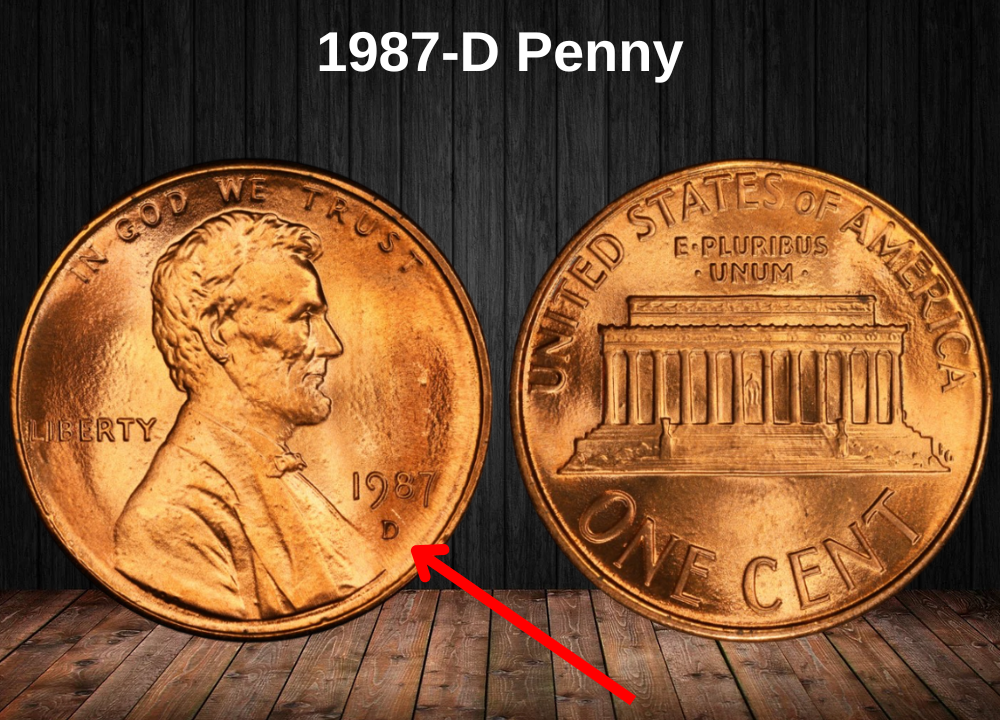
In 1987, the Denver Mint topped production, striking an impressive 4,879,389,514 Lincoln Memorial pennies—the highest mintage for that year.
Just like the Philadelphia issue, 1987-D pennies are extremely common across all conditions and can still be found in everyday change. However, most of the coins you’ll come across will show signs of heavy wear and have little collector value.
In circulated grades, a brown 1987-D penny typically sells for $0.05 to $0.10, barely more than face value.
Even uncirculated coins from Denver are easy to come by and relatively inexpensive. For example, a coin graded MS66 can often be picked up for as little as $5.
While full red specimens offer a bit more visual appeal, they’re still affordable due to the overwhelming supply. A 1987-D penny graded MS67 Red might bring in around $28.
The good news is, because these coins are so budget-friendly, they make a great starting point for new collectors looking to build a Lincoln cent set without spending a fortune.
1987-S Proof Penny Value
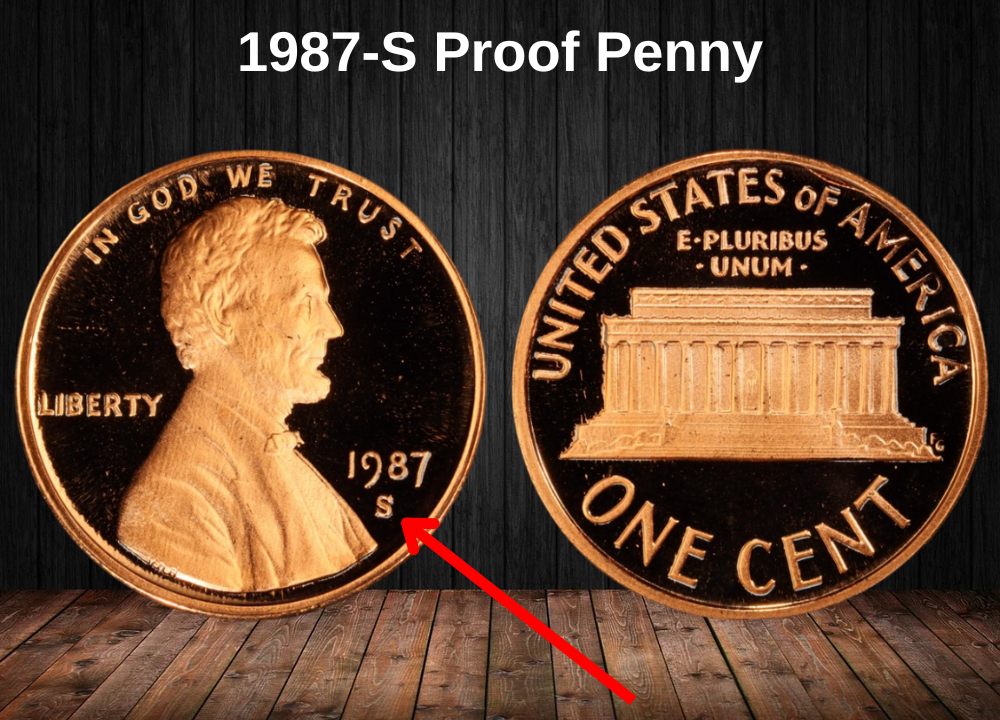
In 1987, the San Francisco Mint produced approximately 4,227,728 proof Lincoln pennies.
Proof coins are specially made for collectors, featuring sharper strikes, frosted details, and a brilliant, mirror-like finish that enhances their overall appearance.
However, the 1987-S proof pennies don’t command high prices. This is partly because the San Francisco Mint used older, worn dies that resulted in less-than-perfect strikes on these coins. Additionally, the relatively large number of proofs minted that year keeps their market value modest.
On the bright side, you can usually find a well-preserved PF70 proof penny from 1987-S for around $85.
The top-tier 1987-S proof penny is a Deep Cameo variety graded PF70. One such coin fetched a remarkable $2,070 at a Heritage Auction in 2004, showing the potential for exceptional pieces to bring impressive sums.
Rare 1987 Penny Errors List
1987 Doubled Die Date Penny Error
A doubled die error happens when the die used to strike the coin’s design hits the coin more than once, but slightly misaligned each time. This causes a doubling effect on parts of the coin, like the date, images, or lettering.
For some 1987 pennies, this doubling is visible on the year date on the front side (obverse). Coins exhibiting this error can be quite valuable, often selling for up to $150. This popularity makes sense, as doubled die errors are highly sought after by collectors.
1987 Re-Punched Mint Mark Penny Error
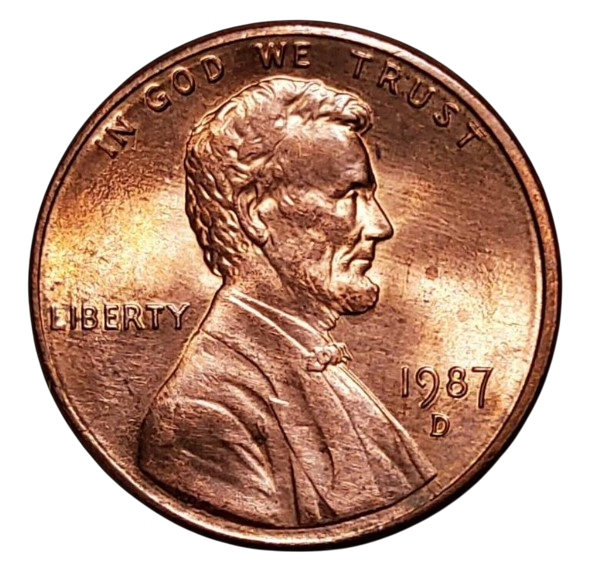
This error happens when the mint mark on the coin is stamped more than once, but slightly misaligned each time. As a result, the primary and secondary mint marks overlap, creating a doubled or shadowed effect.
Collectors highly value re-punched mint mark errors. In the 1987 penny series, this flaw is mostly found on proof coins with a satin finish, where the “S” mint mark on the front (obverse) has been struck multiple times.
Depending on its condition, a 1987 penny showing this re-punched mint mark error can fetch upwards of $125 or more.
1987 Off-Center Penny Error
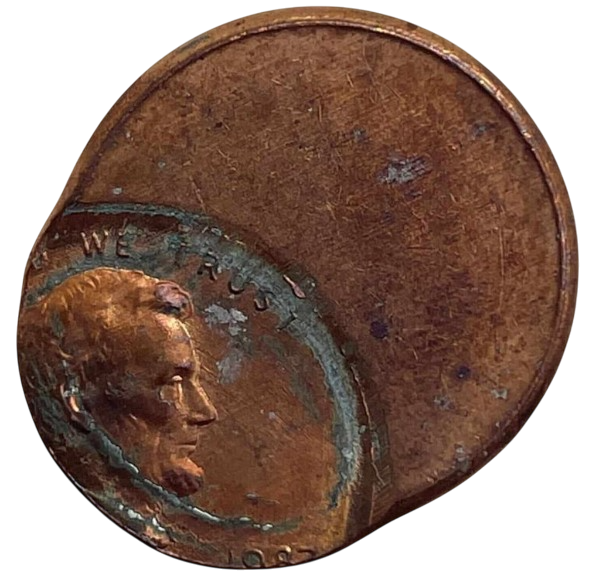
An off-center error happens when the coin’s design is stamped too far from the center, causing parts of the image or lettering to be missing or trimmed off.
Collectors may pay around $100 for a 1987 penny exhibiting this off-center mistake. If the coin also has additional errors—like a strike-through or doubled die—its value can jump significantly, potentially reaching $150 or more, depending on the coin’s condition.
Where to sell your penny?
Now that you know the value of your penny, you might be wondering where to sell it. Don’t worry: here’s a guide to some of the best online platforms where you can easily sell your coins, along with their advantages and disadvantages.
Discover the best platforms for selling coins online (pros and cons).
FAQ about the 1987 Penny
1. What were the key differences in minting technology or materials used in 1987 pennies compared to earlier 1980s issues?
By 1987, the U.S. Mint had further refined the copper-plated zinc composition and improved planchet preparation, resulting in pennies with more consistent thickness and enhanced plating adhesion, which reduced surface imperfections compared to early 1980s pennies.
2. Are there any rare or notable die varieties, such as doubled dies or repunched mint marks, specific to the 1987 penny?
Yes. While less dramatic than some earlier years, 1987 pennies exhibit minor doubled die obverse varieties and repunched mint marks (RPMs), particularly on Denver (D) minted coins. These subtle varieties can increase a coin’s collector value.
3. How does the strike quality of 1987 pennies compare between the Philadelphia and Denver mints?
Typically, Denver-minted 1987 pennies show slightly sharper details and crisper rims due to different die polishing and minting conditions. Philadelphia coins may appear a bit softer in strike, though this varies based on individual dies and coin condition.
4. What environmental factors influence the toning and preservation of 1987 pennies, and how does this affect their collectability?
Natural toning from exposure to air and humidity can create attractive color patterns like reds and browns, enhancing desirability. However, improper storage can cause corrosion or spotting, significantly decreasing a coin’s value.
5. Are there any known mint errors or off-metal strikes involving the 1987 penny?
Off-metal strikes are very rare for 1987 pennies. Some minor errors like off-center strikes, die cracks, and weak strikes have been reported, but they usually hold modest premiums unless in exceptional condition.
6. How can collectors differentiate between original mint toning and artificially induced toning on 1987 pennies?
Original toning is usually uniform, with gradual color changes and natural patterns. Artificial toning often appears unnatural with blotchy or overly vivid colors, and may show signs of chemical treatment under magnification or UV light inspection.
7. In the context of Lincoln cents history, what does the 1987 penny represent in terms of production trends or mint policies?
The 1987 penny reflects the Mint’s ongoing commitment to cost-effective coinage while improving coin durability and aesthetic quality, maintaining the copper-plated zinc standard that had stabilized production costs since 1982.


















































